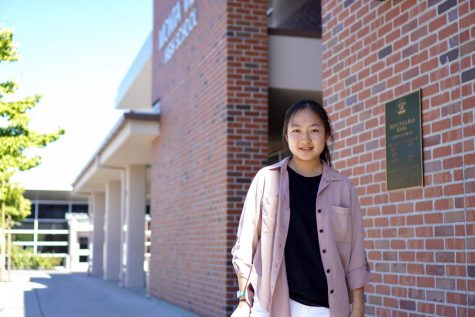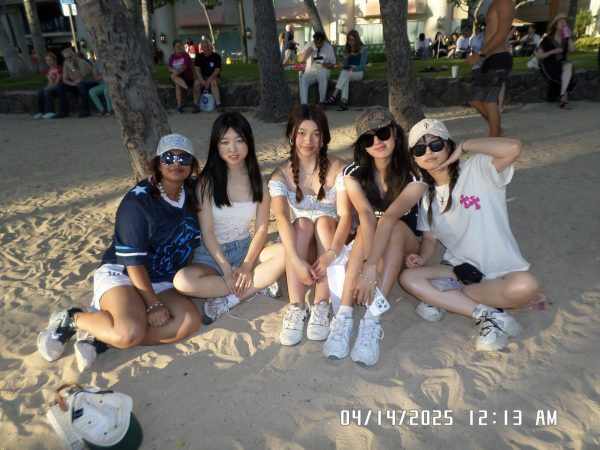More Cupertino residents start using NextDoor
Exploring how the city stays connected and updated through a social-networking app
As the shelter in place order keeps individuals and families isolated at home, there has been an increase in the number of Cupertino residents who have joined the app NextDoor, a social network for people to communicate, share information and offer assistance to their neighbors. Neighborhoods are divided into different regions such as Monta Vista — residents that live near MVHS would belong in this area.
One of the leads — someone who verifies members and manages posts to help everything run smoothly — and resident Jean Bedord states that compared to other social networks, NextDoor is a site that allows nearby communities to exchange posts and comments as opposed to posting to the entire public.
“The geographic limitation really helps because you know the message is only going out to people that can immediately help you or provide assistance or [is] interested in that information,” Bedord said. “It’s really micro news.”
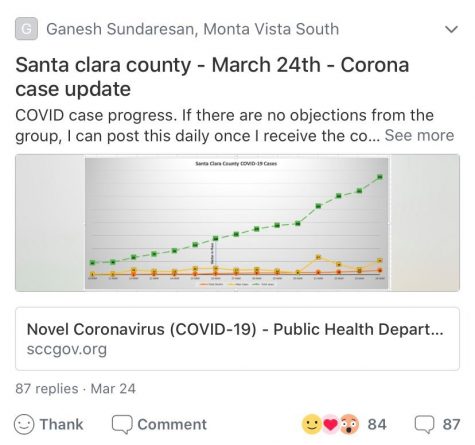
A local resident posts daily updates about Coronavirus rates in Santa Clara County
Resident and MVHS parent Rich Williams has been using NextDoor for six years and checks it approximately twice a day. During lockdown, he benefits from reading information and updates about COVID-19 that pose immediate impacts to his neighbors.
“[NextDoor is] the magnifying glass on what affects me locally,” Williams said. “[It] is a clearinghouse of information and people who are coming from all different walks of life in different industries [and] different levels of education. It’s a way for people to sift through information on a subject matter. It might also [be] a way for someone to clear up misinformation on a subject matter.”
Similar to Williams, resident and Monta Vista neighbor Sarah Kopy also uses NextDoor as a way to update herself with news circulating around her community. Kopy has been using NextDoor for two years now. Occasionally, she reads about lost pets and crime statistics that are posted by her neighbors.
Due to the recent news about individuals buying weapons out of fear of crimes such as burglary and theft, Kopy believes that staying aware of what’s happening around her provides security and safety for her and her community.
“You are aware that [crime is] happening in your neighborhood, and you might pay more attention to a suspicious car and maybe write down the license plate, and help the police department that way,” Kopy said. “[NextDoor] gives [neighbors] information and without it, people might panic. If they can reach out to someone [and] say ‘this is what’s going on, is this normal, what should I expect or should I call the police?’ People are a little bit more comforted because they can contact somebody in their neighborhood.”
Recently, Resident and Monta Vista neighbor Kari Arey noticed that many residents have run low on supplies, elders are at extremely high risk when going outside and some residents have other issues they want solved.
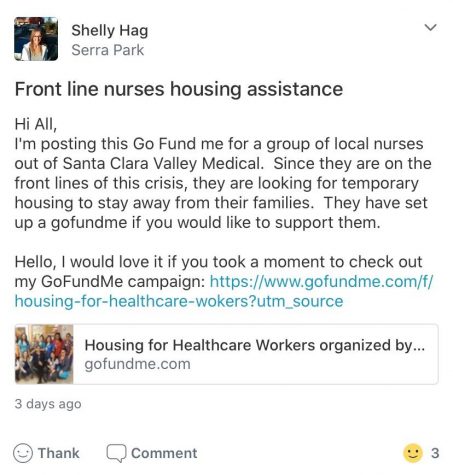
Residents often ask each other to help out or donate supplies to hospitals, seniors, or people in need of help
As a result, many have observed that neighbors often offer to help many of these individuals and institutions by communicating through NextDoor. For example, there are users who post updates on which stores have stocked up on supplies and where to donate extra medical supplies, as well as where to drop food off.
“If I had a problem, I could throw it out [and] say ‘I have a problem, what do you suggest,’ and [I’m] tapping into thousands and thousands of neighbors out there,” Bedord said. “Invariably, one of them will come up with a solution that is just spot on. Of course, I get other comments that [some] didn’t read it [or] they didn’t understand the problem, but somebody will.”
Arey and her husband have recently run out of masks after noticing they had symptoms similar to those associated with the coronavirus. To protect her grandmother, who lives with her, Arey reached out to her neighbors on NextDoor to ask for sanitizing resources and face masks. To her surprise, countless residents started stopping by her home and donating supplies to her and her family.

Resident Kari Arey and her neighbors often post about Asian and Asian American mistreatment during the COVID-19 outbreak
“There was an outpour of just kindness and that’s really heartwarming to see in [a] community,” Arey said. “The really amazing thing that I’ve seen is even though there are differences in opinions [between] people, people put those aside when people do need help.”
Resident Kathleen Smith, who has witnessed communities helping Arey’s family, believes that her current neighborhood reminds her of the neighborhood where she grew up because they would also help each other in times of need.
“I think it’s just human kindness, and we’re supposed to do that,” said Smith. “I think it’s a good idea especially now. Now is a good time people are really starting to rely on their neighbors and check in.”
For Arey, NextDoor is also a tool to educate her community about important social issues such as racism and xenophobia. After an employee of a grocery shop made racist and xenophobic comments against an Asian customer when checking out their items, individuals like Arey decided to post descriptions of the incident on NextDoor, as well as posting petitions and information to receive justice for the Asian and Asian American Community.
“With the rise of people getting tons of positive [tests] and the rise of the death toll, I feel people are going to be more desperate in pointing the finger at a certain race and it’s already started,” Arey said. “I’m afraid it’s gonna escalate into more violence. So, I feel it’s really important to have these discussions in our communities. Even though we don’t see it directly in Cupertino, it can come to our communities and we want to educate them [on] how to properly deal with it.”
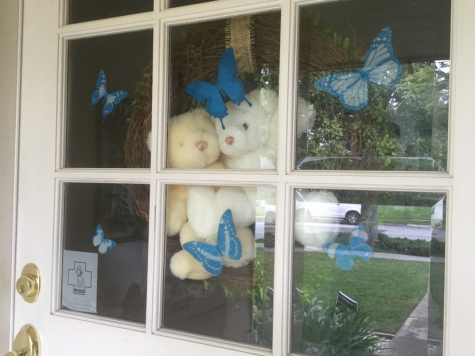
Resident Kathleen Smith was inspired by other friends to encourage her neighbors to put up teddy bears on windows
Amidst all the negative impacts that COVID-19 has caused, residents have started posting positive messages and challenges to help neighbors cope with everything happening. For example, Smith started a project where she told her neighbors to put teddy bears near their windows. Inspired by her cousin in Dublin and many others who committed to the challenge, Smith decided to start the trend in her community as a way for kids to find enjoyment counting the number of bears they see on walks and for her neighbors to feel more connected.
“We’re all hungry for that social connection,” Smith said. “So to put the bears in the window, it’s just another way to let people know, ‘hey, we’re still here, we’re connecting.’ I think that’s really important right now, as California [has] been under quarantine a lot longer than most other places.”
To Smith, NextDoor has opened new paths for neighbors to form relationships with each other. She notices that Cupertino is a very work-oriented city, where individuals work for long hours and rarely have time to socialize with each other on a regular basis. Since many are no longer able to go outside to work, they have more time to rest and communicate with new people through NextDoor according to Smith.
“If anything good comes out of all of this craziness that we’re living in right now, it’s maybe that we’re starting to realize face-to-face socializations are more important than we thought they are, and that our phones and our apps don’t take over that,” Smith said. “But in the meantime, they’re incredibly useful to help facilitate those relationships.”
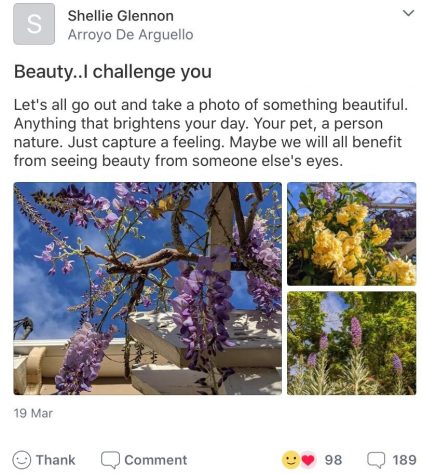
As a way to spread positivity and encouragement to the community, neighbors often post light-hearted messages and challenges
Many residents agree that NextDoor has helped connect their communities together by forming digital relationships and notifying residents about what’s happening to people around them. Williams states that there is a great value in understanding the people around him since they are the only ones who can immediately help during an emergency while the city is under shelter in place.
Similar to Williams, Bedord believes that social distancing has made others realize the importance of a community since there is no one else who would be able to immediately help out; thus, NextDoor is a beneficial app to letting neighbors know when to help.
“It goes back to the old idea: back before we had the internet, back before we had all this technology, particularly in small towns, you were the only resource,” Bedord said. “You can’t go to the federal government, you can’t go to the state. Who’s going to help you? It’s the people in your own local area.”
Agreeing with Bedord, Arey also understands the importance of communicating with neighbors since it is natural for residents to feel isolated and anxious after staying at home for a long time.
‘Human beings are social by nature. Personally for myself, the act of [social distancing] is not difficult,” Arey said. “But what comes with that is people like myself [who] really rely on the physical touch of people like hugging, shaking hands and all of that. [NextDoor] provides an alternate outlet for us to keep on socializing with others. Honestly, I don’t think I would be able to keep my sanity if I was in here and I wasn’t in contact with anybody. As long as our community focuses on the bigger picture and knows that we have to do the social distancing, then we’re going to be able to move ahead faster in trying to eliminate the spread of the disease of the virus.”
